Page 196 of 473
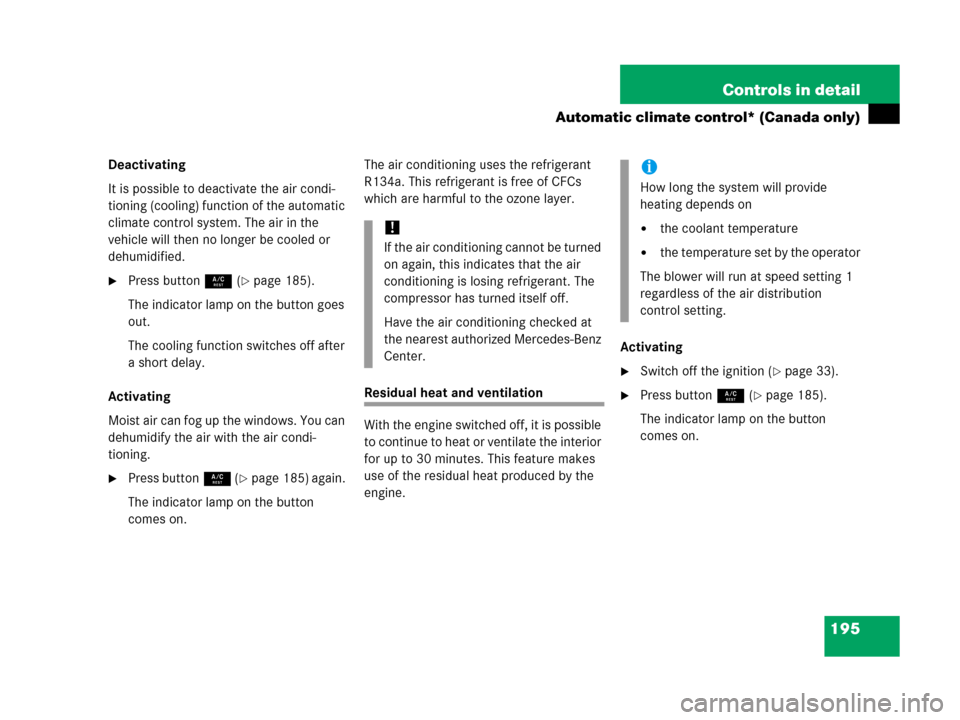
195 Controls in detail
Automatic climate control* (Canada only)
Deactivating
It is possible to deactivate the air condi-
tioning (cooling) function of the automatic
climate control system. The air in the
vehicle will then no longer be cooled or
dehumidified.
�Press button9 (�page 185).
The indicator lamp on the button goes
out.
The cooling function switches off after
a short delay.
Activating
Moist air can fog up the windows. You can
dehumidify the air with the air condi-
tioning.
�Press button9 (�page 185) again.
The indicator lamp on the button
comes on.The air conditioning uses the refrigerant
R134a. This refrigerant is free of CFCs
which are harmful to the ozone layer.
Residual heat and ventilation
With the engine switched off, it is possible
to continue to heat or ventilate the interior
for up to 30 minutes. This feature makes
use of the residual heat produced by the
engine.Activating
�Switch off the ignition (�page 33).
�Press button9 (�page 185).
The indicator lamp on the button
comes on.
!
If the air conditioning cannot be turned
on again, this indicates that the air
conditioning is losing refrigerant. The
compressor has turned itself off.
Have the air conditioning checked at
the nearest authorized Mercedes-Benz
Center.
i
How long the system will provide
heating depends on
�the coolant temperature
�the temperature set by the operator
The blower will run at speed setting 1
regardless of the air distribution
control setting.
Page 247 of 473

246 Controls in detail
Driving systems
1Sets current or higher speed
2Sets current or lower speed
3Cancels cruise control
4Resumes at last set speed
Setting current speed
�Accelerate or decelerate to the desired
speed.
�Briefly lift1 or depress2 the cruise
control lever.
The current speed is set.
�Remove your foot from the accelerator
pedal.
Cruise control is activated.Canceling cruise control
There are several ways to cancel cruise
control:
�Step on the brake pedal.
Cruise control is canceled. The last
speed set is stored for later use.
or
�Briefly push the cruise control lever to
position3.
Cruise control is canceled. The last
speed set is stored for later use.
i
On uphill or downhill grades, cruise
control may not be able to maintain the
set speed. Once the grade eases, the
set speed will be resumed.
!
Moving the gear selector lever to
positionN while driving also cancels
cruise control. However, the gear
selector lever should not be moved to
positionN while driving, except to
coast when the vehicle is in danger of
skidding (e.g. on icy roads).
i
The last stored speed is canceled when
you turn off the engine.
Page 248 of 473
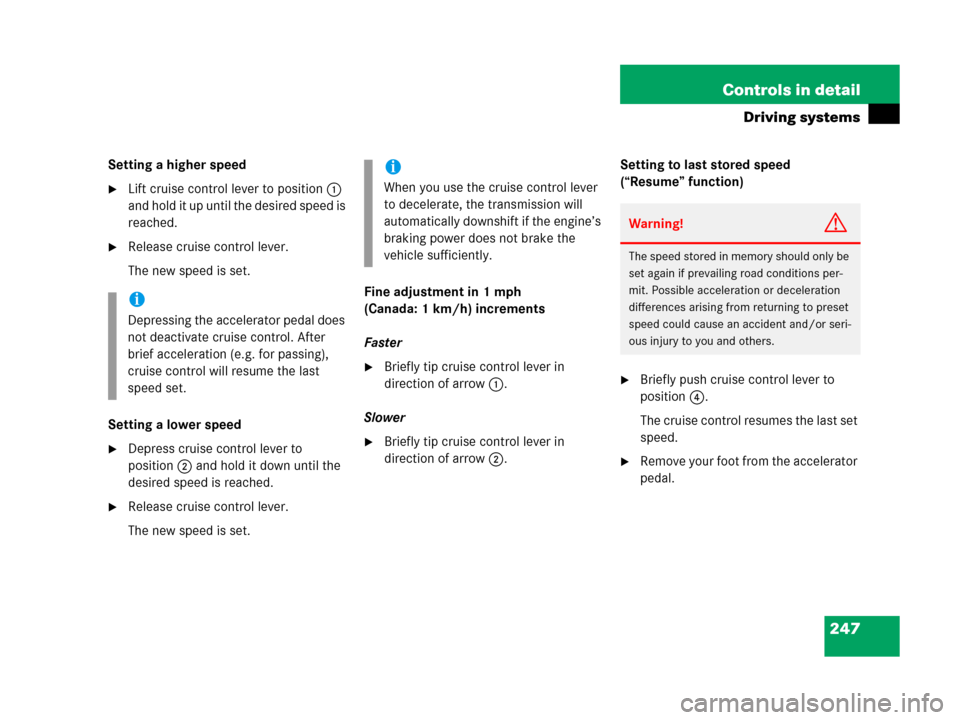
247 Controls in detail
Driving systems
Setting a higher speed
�Lift cruise control lever to position1
and hold it up until the desired speed is
reached.
�Release cruise control lever.
The new speed is set.
Setting a lower speed
�Depress cruise control lever to
position2 and hold it down until the
desired speed is reached.
�Release cruise control lever.
The new speed is set.Fine adjustment in 1 mph
(Canada: 1 km/h) increments
Faster
�Briefly tip cruise control lever in
direction of arrow1.
Slower
�Briefly tip cruise control lever in
direction of arrow2.Setting to last stored speed
(“Resume” function)
�Briefly push cruise control lever to
position4.
The cruise control resumes the last set
speed.
�Remove your foot from the accelerator
pedal.
i
Depressing the accelerator pedal does
not deactivate cruise control. After
brief acceleration (e.g. for passing),
cruise control will resume the last
speed set.
i
When you use the cruise control lever
to decelerate, the transmission will
automatically downshift if the engine’s
braking power does not brake the
vehicle sufficiently.
Warning!G
The speed stored in memory should only be
set again if prevailing road conditions per-
mit. Possible acceleration or deceleration
differences arising from returning to preset
speed could cause an accident and/or seri-
ous injury to you and others.
Page 262 of 473
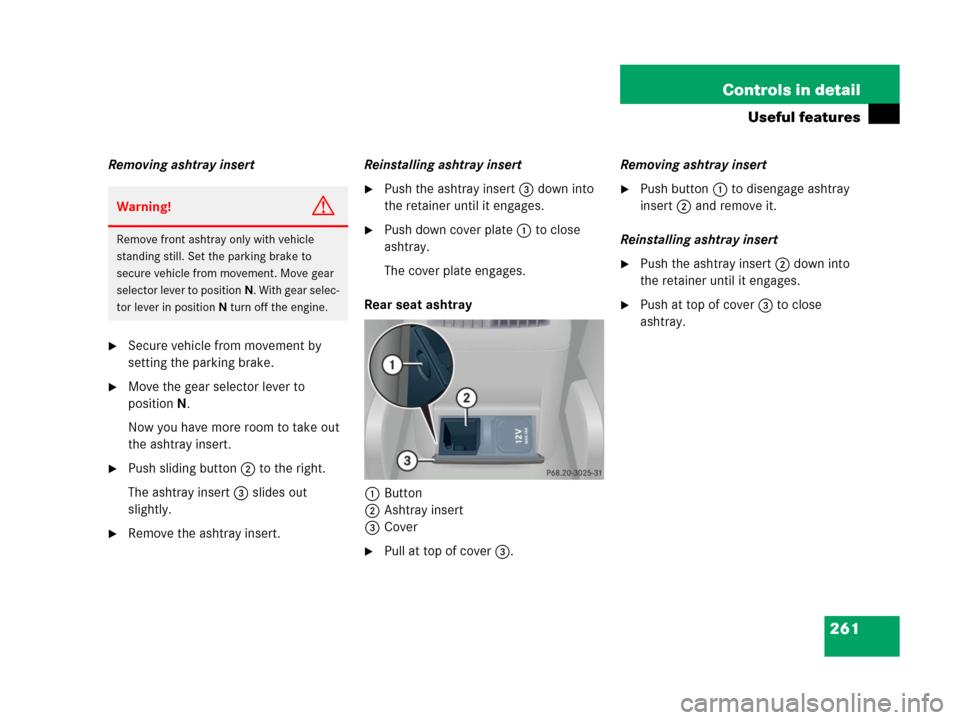
261 Controls in detail
Useful features
Removing ashtray insert
�Secure vehicle from movement by
setting the parking brake.
�Move the gear selector lever to
positionN.
Now you have more room to take out
the ashtray insert.
�Push sliding button2 to the right.
The ashtray insert3 slides out
slightly.
�Remove the ashtray insert.Reinstalling ashtray insert
�Push the ashtray insert3 down into
the retainer until it engages.
�Push down cover plate1 to close
ashtray.
The cover plate engages.
Rear seat ashtray
1Button
2Ashtray insert
3Cover
�Pull at top of cover3.Removing ashtray insert
�Push button1 to disengage ashtray
insert2 and remove it.
Reinstalling ashtray insert
�Push the ashtray insert2 down into
the retainer until it engages.
�Push at top of cover3 to close
ashtray.
Warning!G
Remove front ashtray only with vehicle
standing still. Set the parking brake to
secure vehicle from movement. Move gear
selector lever to positionN. With gear selec-
tor lever in positionN turn off the engine.
Page 264 of 473
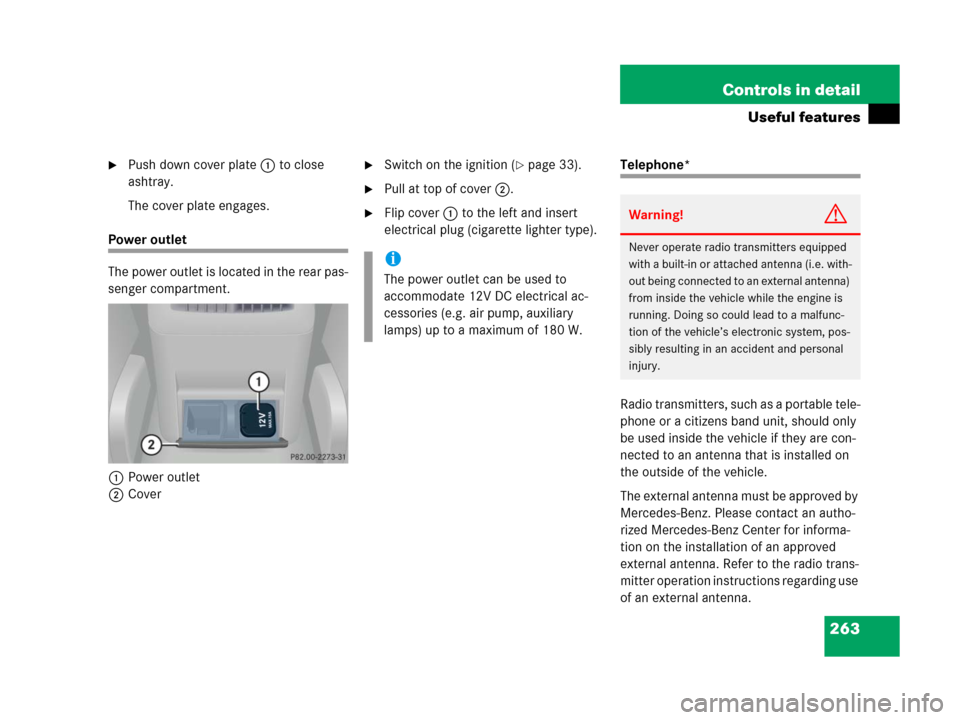
263 Controls in detail
Useful features
�Push down cover plate1 to close
ashtray.
The cover plate engages.
Power outlet
The power outlet is located in the rear pas-
senger compartment.
1Power outlet
2Cover
�Switch on the ignition (�page 33).
�Pull at top of cover2.
�Flip cover1 to the left and insert
electrical plug (cigarette lighter type).
Telephone*
Radio transmitters, such as a portable tele-
phone or a citizens band unit, should only
be used inside the vehicle if they are con-
nected to an antenna that is installed on
the outside of the vehicle.
The external antenna must be approved by
Mercedes-Benz. Please contact an autho-
rized Mercedes-Benz Center for informa-
tion on the installation of an approved
external antenna. Refer to the radio trans-
mitter operation instructions regarding use
of an external antenna.
i
The power outlet can be used to
accommodate 12V DC electrical ac-
cessories (e.g. air pump, auxiliary
lamps) up to a maximum of 180 W.
Warning!G
Never operate radio transmitters equipped
with a built-in or attached antenna (i.e. with-
out being connected to an external antenna)
from inside the vehicle while the engine is
running. Doing so could lead to a malfunc-
tion of the vehicle’s electronic system, pos-
sibly resulting in an accident and personal
injury.
Page 275 of 473
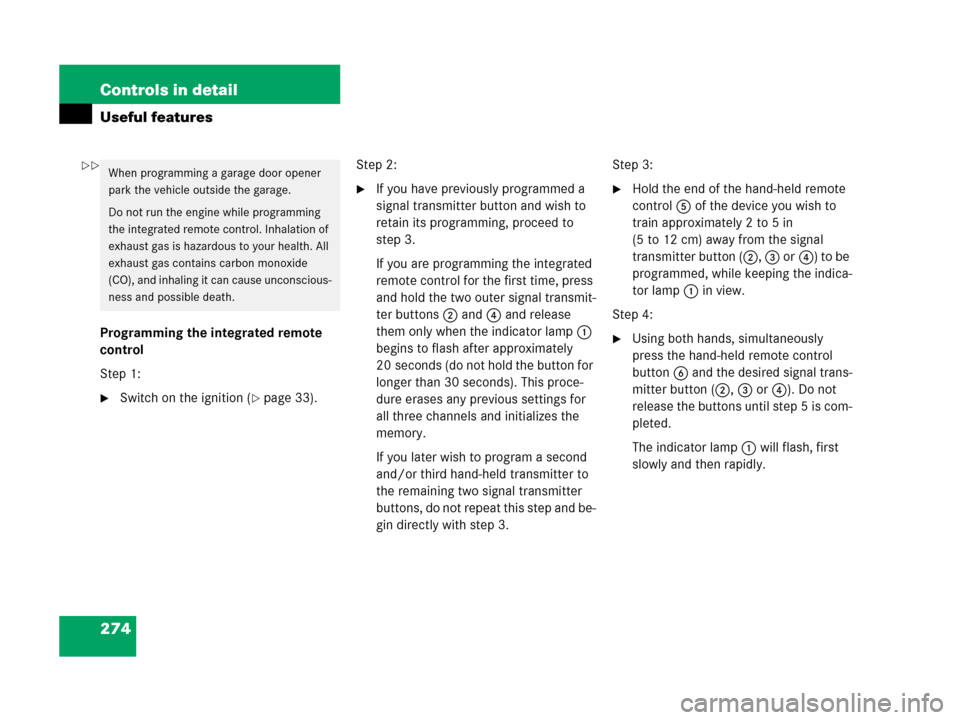
274 Controls in detail
Useful features
Programming the integrated remote
control
Step 1:
�Switch on the ignition (�page 33).Step 2:
�If you have previously programmed a
signal transmitter button and wish to
retain its programming, proceed to
step 3.
If you are programming the integrated
remote control for the first time, press
and hold the two outer signal transmit-
ter buttons2 and4 and release
them only when the indicator lamp1
begins to flash after approximately
20 seconds (do not hold the button for
longer than 30 seconds). This proce-
dure erases any previous settings for
all three channels and initializes the
memory.
If you later wish to program a second
and/or third hand-held transmitter to
the remaining two signal transmitter
buttons, do not repeat this step and be-
gin directly with step 3.Step 3:�Hold the end of the hand-held remote
control5 of the device you wish to
train approximately 2 to 5 in
(5 to 12 cm) away from the signal
transmitter button (2, 3 or4) to be
programmed, while keeping the indica-
tor lamp1 in view.
Step 4:
�Using both hands, simultaneously
press the hand-held remote control
button6 and the desired signal trans-
mitter button (2, 3 or4). Do not
release the buttons until step 5 is com-
pleted.
The indicator lamp1 will flash, first
slowly and then rapidly.
When programming a garage door opener
park the vehicle outside the garage.
Do not run the engine while programming
the integrated remote control. Inhalation of
exhaust gas is hazardous to your health. All
exhaust gas contains carbon monoxide
(CO), and inhaling it can cause unconscious-
ness and possible death.��
Page 282 of 473
281 Operation
The first 1 000 miles (1 500 km)
Driving instructions
At the gas station
Engine compartment
Tires and wheels
Winter driving
Maintenance
Vehicle care
Page 283 of 473

282 Operation
In the “Operation” section you will find
detailed information on operating, main-
taining and caring for your vehicle.
The first 1 000 miles (1 500 km)
The more cautiously you treat your vehicle
during the break-in period, the more satis-
fied you will be with its performance later
on.
�Drive your vehicle during the first
1 000 miles (1 500 km) at varying but
moderate vehicle and engine speeds.
�During this period, avoid heavy loads
(full throttle driving) and excessive
engine speeds (no more than
2/3 of
maximum rpm in each gear).
�Shift gears in a timely manner.
�Avoid accelerating by kick-down.
�Do not attempt to slow the vehicle
down by shifting to a lower gear using
the gear selector lever.
�Select positions3,2 or1 only when
driving at moderate speeds (for hill
driving).
�SelectC as the preferred shift program
(
�page 161) for the first 1 000 miles
(1 500 km).After 1 000 miles (1 500 km) you may
gradually increase vehicle and engine
speeds to the permissible maximum.
All of the above instructions, as may apply
to your vehicle type, also apply when
driving the first 1 000 miles (1 500 km)
after the engine or the rear differential has
been replaced.
!
Additional instructions:
�During the first 1 000 miles
(1 500 km), do not exceed a speed
of 85 mph (140 km/h).
�During this period, avoid engine
speeds above 4 500 rpm in each
gear.
i
Always obey applicable speed limits.